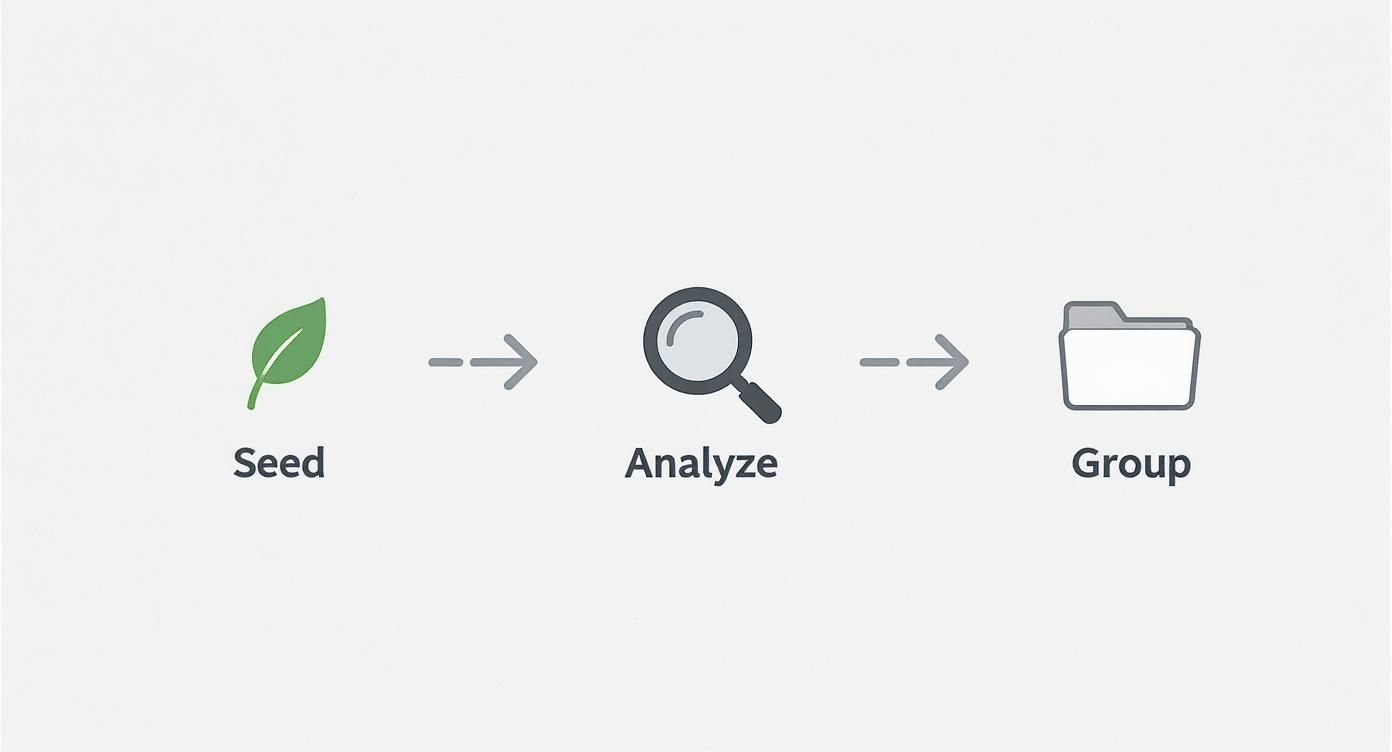The Performance-Driven Guide to Keywords for Amazon Listings
Master keywords for amazon listings with our guide—learn to research, validate, and place terms that drive sales.

Your keywords for Amazon listings are the bridge between a customer's search and your product's sales receipt. They are the exact phrases shoppers use to find products like yours. A performance-driven keyword strategy isn't about guesswork; it's about identifying these high-intent terms and embedding them into your title, bullet points, and backend fields to drive visibility, traffic, and profitable growth.
Why Your Keyword Strategy Is a Primary Growth Lever

Treating keywords for Amazon listings as a one-off SEO task is a costly mistake made by too many brands. Keywords are your most direct line into customer intent, providing critical business intelligence that dictates profitability, organic rank, and your ability to scale.
A winning strategy isn't about stuffing your listing with generic terms. It’s about leveraging performance data to understand what your customers are really looking for.
This is where your Pay-Per-Click (PPC) campaigns become an indispensable R&D tool. By running strategic ad campaigns, you access real-world performance data. You learn which terms convert to sales, which attract low-intent clicks, and which high-value phrases your competitors are sleeping on. This data creates a powerful flywheel: paid advertising insights directly fuel your organic growth, creating a more defensible market position.
A Tale of Two Brands: A Data-Backed Scenario
Consider two brands selling identical premium yoga mats. Their keyword strategy is the only variable.
- Brand A targets broad terms like "yoga mat" and "exercise mat." They generate traffic, but their conversion rate is abysmal. Their Advertising Cost of Sale (ACOS) soars as they compete with thousands of sellers on price.
- Brand B uses PPC discovery campaigns to unearth a high-performance keyword: "eco friendly non slip cork yoga mat." This long-tail phrase has lower search volume, but the searcher's intent is surgical. Brand B’s ACOS is profitable, and every PPC-driven sale sends a powerful relevance signal to Amazon's A10 algorithm.
Brand B's data-led strategy achieves higher organic rankings for the terms that matter, protects profit margins, and establishes a strong market foothold. They aren't just selling a commodity; they are providing a specific solution for a defined customer. This mindset is a critical component of the proven strategies to increase ecommerce sales that category leaders deploy.
The performance gap is not incremental; it's exponential.
Keyword Strategy Impact on Key Performance Metrics
| Metric | Generic Keyword Strategy | Strategic Keyword Strategy |
|---|---|---|
| Visibility | High traffic, low relevance | Targeted traffic, high relevance |
| Conversion Rate | Low (under 2%) | High (often over 10%) |
| ACOS | Unsustainable (often 40%+) | Profitable (under 25%) |
| Organic Rank | Stagnates on competitive terms | Ranks quickly for high-intent terms |
| Profitability | Minimal or negative | Strong and sustainable |
As the data shows, a strategic approach fundamentally alters the financial health and long-term viability of a product.
Keywords and the A10 Algorithm
This isn't theory; it's how Amazon's A10 search algorithm is engineered to operate. The algorithm prioritizes relevance, sales history, and conversion rates to determine product ranking.
By focusing on keywords with a monthly search volume between 500 to 5,000 searches and a manageable number of competitors, you hit the efficiency sweet spot. You target terms with sufficient demand to drive volume but without the crushing competition that inflates ad costs.
The Headline Takeaway: Your keyword strategy is not a line item. It's the central nervous system connecting your advertising, organic ranking, and profitability. Stop treating it as an afterthought and start leveraging it as your primary tool to boost your overall Amazon sales.
Building Your Foundational Keyword List
A robust keyword strategy is built on a comprehensive foundation. Guesswork is not a strategy. The objective is to compile a master list of terms reflecting actual shopper behavior—a playbook you will validate, test, and refine with performance data.
This isn’t about finding one or two "money" keywords. It's about mapping a broad spectrum of primary, secondary, and long-tail phrases that capture customers at every stage of their buying journey.
Starting with Seed Keywords
First, identify your core "seed" keywords. These are the broad, foundational terms that describe your product at its most basic level. Think like a customer with a general need but no specific product features in mind.
For a pour-over coffee maker, your seed keywords are:
- pour over coffee maker
- drip coffee brewer
- manual coffee maker
These terms are your starting block, not the finish line. They are often highly competitive and may have lower conversion rates, but they are essential for expanding into more specific, and ultimately more profitable, search queries.
Uncovering How Your Customers Actually Talk
With seed keywords established, the intelligence-gathering begins. The goal is to expand your list with the exact language your target audience uses. This is where manual research provides a competitive advantage that automation alone cannot replicate.
Analyze Amazon's Search Bar
Amazon’s search bar autocomplete is a direct feed of popular customer queries. Type your seed keywords and meticulously record Amazon's suggestions. For "pour over coffee maker," you'll likely see:
- pour over coffee maker with reusable filter
- pour over coffee maker single cup
- pour over coffee maker set with kettle
These suggestions are not random; they represent high-volume searches. They reveal the features, use cases, and product configurations customers are actively seeking. Every relevant suggestion belongs on your master list.
Deconstruct Your Top Competitors' Listings
Your top competitors provide a free, public roadmap to what works. Analyze the top five best-sellers in your category. Scrutinize their titles, bullets, and descriptions for recurring phrases and highlighted benefits.
Are they all emphasizing "BPA-free," "borosilicate glass," or "stainless steel filter"? These aren't just product specs; they are proven keywords for Amazon listings that resonate with the market.
Mine Customer Reviews for Hidden Gems
Customer reviews and Q&A sections are the most authentic source of keyword intelligence available. Here, shoppers describe—in their own words—their purchase drivers, use cases, and pain points.
You might discover customers mentioning they use their coffee maker for "camping" or that it’s "easy to clean." These are high-intent, long-tail keywords derived directly from the voice of the customer.
The most powerful keywords are sourced from the customer. Mining reviews uncovers not just search terms, but the core needs and desires that drive conversions.
This hands-on research is a key differentiator. A recent Amazon report revealed that 75% of shoppers use the search bar to find products, even if they start from a category page. Success hinges on aligning your listing with the precise terms customers use. Tools like autocomplete and PPC search term reports are vital for uncovering the high-conversion keywords that drive sales, not just vanity clicks. You can explore the full research on Amazon's keyword strategies to dig deeper into Amazon's own data.
Put Your Keywords to the Test with PPC
Your initial keyword list is a well-researched hypothesis. Now it's time to validate it with real-world data. Stop speculating which keywords drive revenue and start using your advertising budget as a strategic research tool.
This is a core pillar of our philosophy: Amazon PPC is not an expense; it's a strategic investment in market intelligence. This data directly fuels organic ranking and profitability, creating a flywheel where ad spend uncovers real customer search behavior, which then informs your listing optimization for a virtuous cycle of higher rankings and more efficient ad spend.

This process—seeding campaigns, analyzing performance data, and refining your core keyword set—is the foundation of an adaptive, performance-driven strategy.
Set Up Your Discovery Campaigns
Structure your initial campaigns with a single objective: harvesting new, high-value search terms. Profitability (ACOS) is not the primary KPI at this stage; data acquisition is.
Two campaign types are essential for this mission:
- Automatic Campaigns: Let Amazon's algorithm do the initial work. Provide your product listing, and Amazon will match your ad to customer searches it deems relevant. This is the fastest method for uncovering unexpected but highly relevant keywords for Amazon listings that you may have missed.
- Broad Match Manual Campaigns: Use your initial "seed" keywords with a broad match type. This instructs Amazon to show your ad for close variations, synonyms, and related queries. A broad match on "leather wallet" could capture traffic from "men's bifold wallet," "genuine leather card holder," or "slim front pocket wallet."
Run these campaigns for a minimum of two to four weeks to accumulate a statistically significant data set. You are intentionally casting a wide net to map the entire landscape of relevant search queries.
Dig into the Search Term Report
After your discovery campaigns have run, the Search Term Report in the Advertising Console becomes your most valuable asset. It reveals the exact search queries shoppers used before clicking your ad. This is where hypotheses are confirmed or debunked by real-world behavior.
Analyze the report for metrics that signal purchase intent. Your task is to sift through this raw data and graduate the high-performers into your listing and into more targeted, performance-focused ad campaigns.
A classic mistake is optimizing for clicks. Clicks without conversions are an efficient way to burn your budget. The Search Term Report is invaluable because it connects ad spend directly to sales, revealing which keywords actually drive business results.
How to Validate Keywords with Real Data
As you analyze your report, isolate terms that excel across key performance indicators. These signals separate the revenue-drivers from the budget-drains.
Here’s what to look for:
- High Conversion Rate (CVR): This is the ultimate validation. A keyword with a high CVR indicates a strong product-market fit for that specific search query.
- Low Advertising Cost of Sale (ACOS): ACOS measures ad spend efficiency (Total Ad Spend / Total Ad Sales). A keyword with a low, profitable ACOS is a clear winner.
- High Return on Ad Spend (ROAS): ROAS, the inverse of ACOS (Total Ad Sales / Total Ad Spend), quantifies the revenue generated for every dollar of ad spend. High ROAS confirms a keyword is driving profitable growth.
By leveraging PPC to systematically discover and validate keywords for Amazon listings, you replace guesswork with certainty. You build a strategy based on actual shopper behavior and proven financial performance—the only path to sustainable scale.
For a deeper tactical breakdown, see our complete guide on how to master Amazon PPC keyword research.
Weaving Your Keywords into Your Listing for Maximum Impact

Discovering high-performance keywords is only half the battle. Strategic placement is what triggers Amazon's A10 algorithm to rank your product. The algorithm assigns different weights to different sections of your listing.
Think of it as a hierarchy of importance: a keyword in your title carries significantly more weight than one in your description. Both contribute to relevance, but one is far more impactful.
The Product Title: Your SEO Heavy Hitter
The product title is the single most important location for your keywords. It's the first element both shoppers and the A10 algorithm scan to determine relevance. It carries the most SEO weight.
The strategy is simple: front-load your most important, highest-volume keyword phrase. Follow it with secondary keywords and critical information like brand, material, quantity, or a key feature.
Let’s contrast a weak title with a high-performance one:
- Weak title:
Yoga Mat for Exercise - Powerful title:
[Brand Name] Eco-Friendly Cork Yoga Mat – 5mm Thick Non-Slip Surface for Hot Yoga, Pilates, and Floor Exercises (72" x 24")
The second title is a strategic asset. It leads with the primary product identifier, integrates valuable terms like "non-slip surface" and "hot yoga," and preemptively answers customer questions about material and dimensions. Tools like an Amazon Title Optimizer can help structure this for maximum click-through rate and conversion.
Bullet Points: Where You Sell the Benefits
Your bullet points are the second-most-critical area for keyword placement and are your primary sales pitch. This is the ideal location for secondary and long-tail keywords that didn't fit in the title.
Each bullet point must connect a feature to a tangible benefit while naturally incorporating a keyword. Don't just list specs; articulate value.
- Weak bullet:
Made from cork material. - Strong bullet:
**NATURALLY NON-SLIP GRIP:** Our premium cork surface wicks away moisture, providing an unmatched grip during sweaty hot yoga sessions so you can hold poses with confidence.
The strong example seamlessly integrates the keyword "hot yoga" while solving a key customer pain point. This dual approach boosts both SEO and conversion rate.
Backend Search Terms: Your Secret Weapon
The backend search terms field is a frequently mismanaged opportunity. These keywords are invisible to shoppers but are indexed directly by Amazon's algorithm. This is your space for relevant terms that would be unnatural in your title or bullets.
Use this field for synonyms, common misspellings, and Spanish translations (for the US market). The cardinal rule is to avoid repeating any keywords already present in the visible parts of your listing. It's for supplementary terms only.
CRITICAL: Amazon enforces a strict limit of under 250 bytes (not characters) for this field. Exceeding this limit causes Amazon to ignore the entire field. Be strategic and concise.
This 250-byte limit is a hard ceiling and a common pitfall. Special characters consume more bytes than standard letters. Mismanaging this field negates its entire SEO value.
The Product Description and A+ Content
While the description and A+ Content carry less direct SEO weight than the title or bullets, they are still indexed by Amazon and contribute to overall listing relevance.
Use this space for brand storytelling and to naturally incorporate any remaining long-tail keywords. Address detailed questions, overcome potential objections, and provide the final persuasive push toward conversion.
Keyword Placement Priority and Impact
To optimize effectively, prioritize your efforts based on impact. This hierarchy shows where your focus will yield the greatest returns.
| Listing Section | SEO Impact Weight | Best Practice |
|---|---|---|
| Product Title | Highest | Front-load your most important, highest-volume keywords. |
| Bullet Points | High | Weave in secondary keywords and long-tail phrases naturally. |
| Backend Search Terms | Medium | Add synonyms, misspellings, and related terms (under 250 bytes). |
| Product Description / A+ | Low | Use for storytelling and including any remaining long-tail keywords. |
By strategically placing your keywords for Amazon listings according to this hierarchy, you send clear, powerful signals to the A10 algorithm, establishing your product as the most relevant result for a customer's search.
Measuring Performance and Refining Your Strategy
A high-performance keyword strategy is not static; it is dynamic. Market conditions, competitor actions, and customer search behavior are in constant flux. A "set it and forget it" approach guarantees obsolescence.
Category leaders continuously test and iterate. They operate within a cycle of monitoring performance, analyzing data, and refining their strategy. This data-driven approach ensures they stay ahead of the curve, making decisions based on performance metrics, not assumptions.
Tracking Your Keyword Rankings and Performance
You cannot optimize what you do not measure. The first step is to establish clear visibility into your organic keyword performance. This means tracking your rank for your most critical search terms.
Manual searching on Amazon is unreliable and inefficient due to personalized results. It is not a scalable methodology.
Professional tools are essential for accurate tracking. Platforms like Helium 10, Jungle Scout, or Seller Labs provide objective keyword tracking. They chart your ranking over time, quantify progress, and alert you to sudden drops requiring immediate intervention.
For brand-registered sellers, Amazon's Brand Analytics is a non-negotiable tool. The Search Query Performance dashboard provides impression, click, and sales data for specific customer searches, offering a direct view of your brand's performance on the platform.
Connecting Keyword Rank to Sales Velocity
Moving from page three to the top five for "waterproof hiking backpack" is a good vanity metric, but what is its business impact? The critical analysis is connecting ranking changes to sales performance.
Use your business reports in Seller Central. When your rank for a primary keyword improves, do you see a corresponding lift in daily unit sales? Conversely, if your rank for a high-volume term slips, can you identify a correlated dip in revenue?
This connection is paramount. It is the feedback loop that validates your strategy. When you can tie a keyword's organic rank directly to sales figures, you know precisely which terms drive revenue and warrant increased investment in both SEO and PPC.
Triggers for a Keyword Refresh
While a quarterly review is a good baseline, certain market events should trigger an immediate keyword reassessment.
- Seasonality: Keywords for "winter gloves" that perform in November are irrelevant in April. Adapt your strategy to seasonal demand shifts.
- New Competitors: An aggressive new market entrant can disrupt the landscape by bidding on your top terms or uncovering a new niche. Monitor their strategy.
- Evolving Search Behavior: Customer language evolves. "Bluetooth headphones" has been largely supplanted by "wireless earbuds." Stay current with consumer vocabulary.
- Declining Performance: A sustained drop in traffic, sales, or keyword ranks is a clear indicator that your current keyword set is losing efficacy.
The Headline Takeaway: Treat your keyword strategy as an ongoing performance marketing discipline, not a one-time setup task. By leveraging a combination of third-party tools and first-party Amazon data to monitor performance and reacting to market triggers, you build a resilient, profitable growth engine for the long term.
Got Questions About Amazon Keywords? We've Got Answers.
Even sophisticated sellers encounter challenges with Amazon keyword strategy. The platform evolves, and misinformation is rampant. Let's address the most common questions we hear from eCommerce leaders.
How Often Should I Actually Update My Keywords?
There is no one-size-fits-all answer, but a "set it and forget it" approach is a liability. Your keyword strategy must be dynamic. We advise clients to conduct a comprehensive keyword review and refresh at least once per quarter.
However, certain events demand immediate action:
- A sudden drop in sales or organic rank. This is a critical alert that your keyword relevance may have degraded.
- A significant new competitor enters the market. You must analyze their strategy and adapt yours accordingly.
- A key selling season is approaching. Q4 or Prime Day requires a keyword strategy aligned with event-specific search behavior.
On a weekly basis, your PPC Search Term Reports provide a continuous stream of fresh intelligence for making tactical adjustments to backend terms and ad campaigns.
What's the Real Difference Between Frontend and Backend Keywords?
Understanding this distinction is fundamental to effective listing optimization. It's about communicating with two different audiences: the shopper and the algorithm.
Frontend keywords are integrated into the customer-facing components of your listing: the title, bullet points, and A+ Content. These terms must serve two functions: satisfy the A10 algorithm for relevance and persuade a human shopper to convert.
Backend keywords are invisible to customers. They exist in a dedicated field within Seller Central, intended solely for the algorithm. This is the designated space for terms that don't fit naturally on the frontend, such as common misspellings, synonyms, and foreign language equivalents.
Your title and bullets are for keywords that sell. Your backend is for keywords that index. Never waste backend space by repeating keywords already in your title or bullets; this provides zero incremental SEO value.
Can I Use My Competitor's Brand Name in My Keywords?
Yes, but with a critical distinction. You can and should target competitor brand names in your PPC campaigns. This is a standard and effective tactic to capture high-intent traffic from shoppers evaluating your direct competition.
However, you must never place a competitor's brand name in your frontend listing (title, bullets) or in your backend search terms. This is a direct violation of Amazon's Terms of Service and a fast path to listing suspension. Confine all competitor targeting strictly to your advertising campaigns.
How Do I Know if My Keyword Strategy Is Actually Working?
Success is measured by business impact, not vanity metrics. A successful keyword strategy drives profitable growth.
Monitor these key performance indicators:
- Organic Rank for Target Keywords: Use a tracking tool to monitor your position for your top 10-20 commercial keywords. Is your rank trending up or down?
- Total Indexed Keywords: How many unique search terms is Amazon indexing your product for? Growth in this number indicates your optimization efforts are expanding your reach.
- Sales Velocity: This is the ultimate validation. As you achieve higher rankings for high-volume keywords, do you see a direct, measurable increase in daily sales? If not, the keyword may have less commercial intent than you assumed.
Ultimately, a winning strategy results in consistently growing organic visibility for profitable keywords for Amazon listings. This drives more sales and reduces long-term dependency on paid advertising.
At Headline Marketing Agency, we transform these complex challenges into a clear, performance-driven growth plan. We move beyond basic keyword research, leveraging deep PPC intelligence to build integrated strategies that accelerate organic rank, drive profitable sales, and create a sustainable competitive advantage for your brand. Discover how our expert team can scale your Amazon growth.
Wollen Sie Ihre Amazon PPC-Performance aufs nächste Level bringen?
Lassen Sie Ihre Amazon PPC-Kampagnen professionell analysieren und entdecken Sie neue Wachstumsmöglichkeiten.